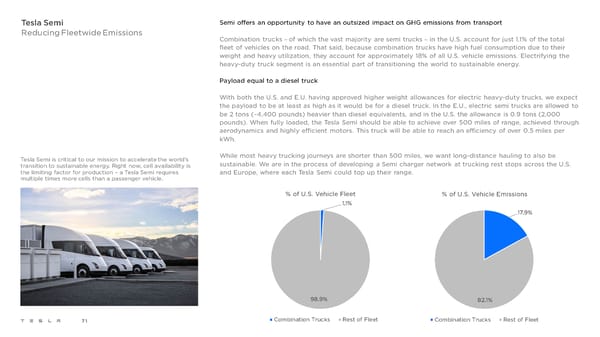Tesla Semi Semi offers an opportunity to have an outsized impact on GHG emissions from transport Reducing Fleetwide Emissions Combination trucks –of which the vast majority are semi trucks – in the U.S. account for just 1.1% of the total fleet of vehicles on the road. That said, because combination trucks have high fuel consumption due to their weight and heavy utilization, they account for approximately 18% of all U.S. vehicle emissions. Electrifying the heavy-duty truck segment is an essential part of transitioning the world to sustainable energy. Payload equal to a diesel truck With both the U.S. and E.U. having approved higher weight allowances for electric heavy-duty trucks, we expect the payload to be at least as high as it would be for a diesel truck. In the E.U., electric semi trucks are allowed to be 2 tons (~4,400 pounds) heavier than diesel equivalents, and in the U.S. the allowance is 0.9 tons (2,000 pounds). When fully loaded, the Tesla Semi should be able to achieve over 500 miles of range, achieved through aerodynamics and highly efficient motors. This truck will be able to reach an efficiency of over 0.5 miles per kWh. Tesla Semi is critical to our mission to accelerate the world’s While most heavy trucking journeys are shorter than 500 miles, we want long-distance hauling to also be transition to sustainable energy. Right now, cell availability is sustainable. We are in the process of developing a Semi charger network at trucking rest stops across the U.S. the limiting factor for production – a Tesla Semi requires and Europe, where each Tesla Semi could top up their range. multiple times more cells than a passenger vehicle. % of U.S. Vehicle Fleet % of U.S. Vehicle Emissions 1.1% 17.9% 98.9% 82.1% 71 Combination Trucks Rest of Fleet Combination Trucks Rest of Fleet
 Tesla 2021 Impact Report Page 70 Page 72
Tesla 2021 Impact Report Page 70 Page 72